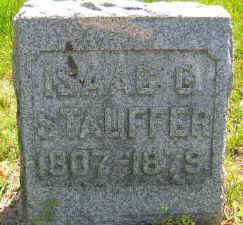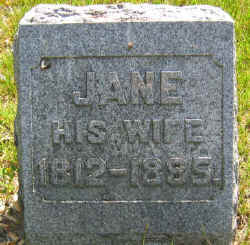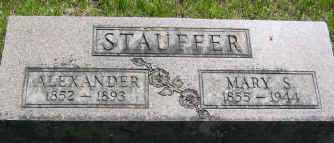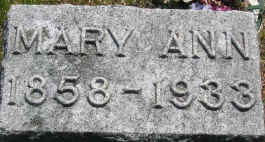|
|
MIGRATION--A FAMILY AFFAIR
As in the migration of his father and grandparents a half century earlier, Abraham Stauffer's
move from Ontario, Canada, to Kent County, Michigan, was not made in isolation.
Two of his sisters and two brothers (one with18 children!), other nieces and
nephews, and at least one of his cousins also migrated to Michigan. As best we
can piece together the clues, they did it during the 1850s and 1860s, Abraham's
family going in 1854. At that time, his father and mother, Samuel and Esther
Stauffer, were still alive. (Samuel would die in 1859 and Esther in 1862.)
It looks as if all five siblings initially settled southeast of Grand Rapids. The Stauffer booklet
(see Early Stauffers) told us that Susannah moved to Kent County, Isaac to Gaines, and Sallie to Caledonia. Further research
revealed that Caledonia is a town in the township of Gaines in the county of Kent. So they actually all moved to the same general area south and southeast of Grand Rapids.
This was quite a few miles outside Grand Rapids in the latter half of the 1800s, though nowadays the whole area in between is suburbia connected by expressways. The area is an even greater distance from Chester Township in Ottawa County northwest of Grand Rapids.
The two sisters and the infant son of Abraham and Magdalena are buried one cemetery (Blain), while the bulk of the Stauffers are buried in another several miles away (Lakeside). In a listing in 1993, the Caledonia Cemetery had 44 Stauffers! On Memorial Day 2006, five family members visited both cemeteries and took pictures.
ISAAC
The brother with the large family was Isaac, the
eldest. If
the dates we have are accurate, he and his wife Jane may have had three or four sets of
twins. Eby says all but three of the eighteen lived to maturity. I have
traced nine of their eleven sons and two of their daughters in Michigan
(daughters are harder to trace because their names change). It looks as if at least one of their
older sons made the
move before Isaac and Jane did.
A number of their children and grandchildren
are found in Kent County in the 1860 and 1870 censuses. It is possible Isaac
and Jane did not make the move until after 1870, which would have been rather
late in their lives, after their brother Abraham had moved to Chester Township
and even after he died. In the
1880 census two years after Isaac's death, Jane is listed as head of the
household to eight other family members. Her daughter Eliza Jane Hillock and
her four children are said to be visiting from Ohio (I found them also in the
Ohio census, so they got counted twice that year). Son Alexander (#15) was 27
and daughter Mary Ann, youngest of the eighteen, was 22. She never married,
lived till 1933, and died still in Caledonia. |
|
 |
| Isaac G. Stauffer (Lakeside
Cemetery, Caledonia, Michigan) |
 |
| Note that Jane, who bore 18
children, outlived her husband by six years. |
 |
 |
SUSANNAH
The oldest sister in the family, Susannah, had married Jacob Kinzey, younger brother to the Susannah
Kinzey who had married her Uncle Daniel. (Yes,
Susannah Kinzey became Susannah Stauffer, and ten years later a Susannah
Stauffer became Susannah Kinzey.) Their oldest apparently remained in
Canada. Of their seven children, a
son and a daughter married sister-and-brother grandchildren of George and Esther
Stauffer Clemens. One of those couples ended up in Ontario and the other in
Michigan, so we can surmise that connections remained between the family
branches in Canada and Michigan. Communications and travel would have improved a great
deal during the first half of that century. Jacob and Susannah lived only until
1862 and 1868. Both died before reaching 60. We're told that
a Stauffer/Kinzey family reunion was held in Kent County in 1903.
SARAH
According to the Stauffer booklet and some Internet records, the youngest sister in the family was Sallie who married Enos Janzen. Censuses and cemetery records, however, give the name as Johnson, and her headstone shows her as Sarah Johnson. It is possible she went by Sallie while growing up but at some point began using Sarah.
Both Janzen and Johnson mean "John's son," so that change is
likely a result of Americanizing their name when or after they moved to
Michigan. Whatever, Enos and Sallie's first six children were born in Canada and the last four in Michigan, so they apparently made the move around 1852 or 1853.
Of ten children, Enos and Sallie had only three sons. Abraham, the oldest, was
born in 1842. That would have put him going on 20 when the Civil War broke out.
We don't know when he joined up or whether it caused trauma in a family whose
mother at least had been raised Mennonite. We don't know where he fought or how
long. All we know is that he died in the War.
We have no
trouble imagining the pain and grief his death brought to the Stauffer community back
in Michigan.
Enos lived to 75 and Sallie to 72. In their household at the time of the 1880
census, daughters
Esther and Mary (ages 27 and 25) were school teachers still living at home,
along with son Henry with wife and baby and youngest sister Sarah. Also
buried in Blain Cemetery with Sallie and Susannah and their husbands is
Jacob, the Johnsons' second son who died at nineteen, two years after
the War was over. For unknown reasons, the old headstones in Blain
are mostly sandstone and are already difficult to read, compared to the
ones at Lakeside, which appear to be made from much harder stone, including some of marble.
JOHN
The youngest member of the family, brother John, moved to Gaines Township, Kent County, long
enough for four of his children to be born and then returned to Canada,
where his last two were born.
I
CAN SEE IT, CAN'T YOU?
When I see how much fun my six grandchildren have together, I can't help think
about those Stauffer families who settled there south of Grand Rapids together. Sallie had ten children, Susannah had seven, Abraham
had at least three with him in Michigan, John had six the years he was there, and when you factor in Isaac's close-to-a-dozen that we know
made it to Michigan, plus grandchildren already being born to the oldest ones,
you have somewhere between two and three dozen cousins, in ages ranging up and
down a scale of thirty years.
Can't you just imagine the family get-togethers, whether they were helping build
each others' homes, celebrating a wedding and whatever other occasions
Stauffers celebrated in those days--or gathering in a cemetery to grieve the loss
of one of their own? Can't you see the men speaking in measured tones about the Civil War, women
sharing news and advice as they cooked
together, half-grown girls lugging the little ones around on their hips, and
little boys dashing around and shouting to each other?
I can.
|